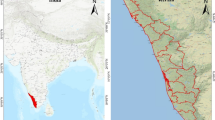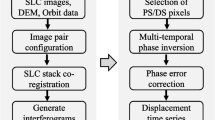Abstract
In this paper, a digital identification method for the extraction of altitudinal belt spectra of montane natural belts is presented. Acquiring the sequential spectra of digital altitudinal belts in mountains at an acceptable temporal frequency and over a large area requires extensive time and work if traditional methods of field investigation are to be used. Such being the case, often the altitudinal belts of a whole mountain or the belts at a regional scale are represented by single points. However, single points obviously cannot accurately reflect the spatial variety of altitudinal belts. In this context, a digital method was developed to extract the spectra of altitudinal belts from remote sensing data and SRTM DEM in the West Kunlun Mountains. By means of the 1km resolution SPOT-4 vegetation 10-day composite NDVI, the horizontal distribution of altitudinal belts were extracted through supervised classification, with a total classification accuracy of 72.23%. Then, a way of twice-scan was used to realize the automatic transition of horizontal maps to vertical belts. The classification results of remote-sensing data could thus be transformed automatically to sequential spectra of digital altitudinal belts. The upper and lower lines of the altitudinal belts were then extracted by vertical scanning of the belts. Relationships between the altitudinal belts based on the montane natural zones concerning vegetation types and the geomorphological altitudinal belts were also discussed. As a tentative method, the digital extraction method presented here is effective at digitally identifying altitudinal belts, and could be helpful in rapid information extraction over large-scale areas.
Similar content being viewed by others
References
Allan, N.J.R. 1986. Accessibility and Altitudinal Zonation Models of Mountains. Mountain Research and Development 6(3): 185–194.
Becker, A. and Bugmann, H. 1999. Global Change and Mountain Regions: the Mountain Research Initiative. GTOS Report 28. Pp.22.
Berthier, E., Arnaud, Y., Vincent, C., et al. 2006. Biases of SRTM in High-mountain Areas: Implications for the Monitoring of Glacier Volume Changes. Geophysical Research Letters 33(8): L08502.1–L08502.5.
Böse, M. 2006. Geomorphic Altitudinal Zonation of the High Mountains of Taiwan. Quaternary International 147:55–61.
Dikau, R. 1989. The Application of a Digital Relief Model to Landform Analysis in Geomorphology. In: Raper, J. (eds.), Three-dimensional Applications in Geographical Information Systems. Taylor & Francis, London. Pp. 51–77.
FENG Jianmeng, WANG Xianping, XU Chongdong, et al. 2006.Altitudinal Patterns of Plant Species Diversity and Community Structure on Yulong Mountains, Yunnan, China. Journal of Mountain Science 24(1): 110–116. (In Chinese)
Fensholt, R., Rasmussen, K., Nielsen, T.T., et al. 2009. Evaluation of Earth Observation Based Long Term Vegetation Trends — Intercomparing NDVI Time Series Trend Analysis Consistency of Sahel from AVHRR GIMMS, Terra MODIS and SPOR VGT Data. Remote Sensing of Environment. 113: 1886–1898.
Guglielmin, M., Aldighieri, B., and Testa, B.2003. PERMACLIM: A Model for the Distribution of Mountain Permafrost, Based on Climate Observations. Geomorphology 51: 245–257.
Hill. R.A., Granica. K., Smith. G.M., et al. 2007. Representation of an Alpine Treeline Ecotone in SPOT 5 HRG Data. Remote Sensing of Environment 110: 458–467.
HOU Xueyu. 1980. Vertical Patterns of Montane Vegetation in China. In: Vegetation of China. Beijing, China: Science Press. Pp.738–745. (In Chinese)
HOU Xueyu. 2001. The Vegetation Atlas of China (1:1 000 000). Beijing, China: Science Press. Pp. 113–124. (In Chinese)
HUANG Xichou. 1962. Structure Types of Vertical Zones for Temperate Mountains in the Eurasia. In: Proceedings of the National 1960 Geographical Symposium. Beijing, China: Science Press. Pp. 67–74. (In Chinese)
Jarlan, L., Mangiarotti, S., Mougin, E., et al. 2008. Assimilation of SPOT/VEGETATION NDVI Data into a Sahelian Vegetation Dynamics Model. Remote Sensing of Environment 112: 1381–1394.
JIANG Su. 1964. Vertical Zonation and Horizontal Differentiation of Physical Geography in Western Sichuan and Northern Yunnan. In: China Geography Society. Proceedings of the 1962 Symposium on Physical Regionalization. Beijing, China: Science Press. Pp.62–69. (In Chinese)
Klose, C. 2006. Climate and Geomorphology in the Uppermost Geomorphic Belts of the Central Mountain Range, Taiwan. Quaternary International 147: 89–102.
Körner C. 1998. A Re-assessment of High Elevation Treeline Positions and their Explanation. Oecologia 115: 445–459.
Kozlowska, A. and Raczkowska, Z. 2002. Vegetation as a Tool in the Characterization of Geomorphological Forms and Processes: An Example from the Abisko Mountains. Geografiska Annaler 84:3–4.
Kuhle, M. 1985. Permafrost and Periglacial Indicators on the Tibetan Plateau from the Himalaya Mountains in the South to the Quilian Shan in the North (28–40°N). Zeitschrift für Geomorphologie N.F. 29(2):183–192.
Kuhle, M. 2007. Altitudinal Levels and Altitudinal Limits in High Mountains. Journal of Mountain Science 4(1): 024–033.
Kullman, L. and Kjallgren, L. 2006. Holocene Pine Tree-line Evolution in the Swedish Scandes: Recent Tree-line Rise and Climate Change in a Long-term Perspective. BOREAS 35(1): 159–168.
LI Shude. 1987. Permafrost and Periglacial Phenomena in West Kunlun Mountains of China. Bulletin of Glacier Research 5:103–109.
LIU Huaxun. 1981. The Vertical Zonation of Mountain Vegetation in China. Acta Geographica Sinica 36(3):267–279. (In Chinese)
Luedeling, E., Sieber, S. and Buerkert, A. 2007. Filling the Voids in the SRTM Elevation Model: A TIN-based Delta Surface Approach. Journal of Photogrammetry & Remote Sensing 62: 283–294.
Lunetta, R.S., Knight, J.F., Ediriwickrema, J., et al. 2006. Land-cover Change Detection Using Multi-temporal MODIS NDVI Data. Remote Sensing of Environment 105(2): 142–154.
MU Guichun and TAN Shukui. 1992. Climatic Geomorphology and Study on an Example of Classification of Climatic Landforms in China. Journal of Hubei University 14(3): 283–289. (In Chinese)
NIU Wenyuan. 1980. Theoretical Analysis of Physico-geographical Zonation. Acta Geographica Sinica 35(4): 288–298. (In Chinese)
Olthof, I. and Pouliot, D. 2010. Treeline Vegetation Composition and Change in Canada’s Western Subarctic from AVHRR and Canopy Reflectance Modeling. Remote Sensing of Environment 114:805–815.
PENG Buzhou, Chen FU, and Pu Lijie. 1999. Progress in the Study on Mountainous Vertical Zonation in China. Chinese Geographical Science 9(4):297–305.
PENG Buzhou, Pu Lijie, Bao Haosheng, et al. 1997. Vertical Zonation of Landscape Characteristic in the Narmjagbarwa Massif of Tibet, China. Mountain Research and Development 17(1): 43–48.
Rabus, B., Eineder, M., Roth, A., et al. 2003. The Shuttle Radar Topography Mission- a New Class of Digital Elevation Models Acquired by Spaceborne Radar. Journal of Photogrammetry & Remote Sensing 57: 241–262.
Rodriguez, E., Morris, C.S. and Belz, J.E. 2006. A Global Assessment of the SRTM Performance. Photogrammetric Engineering and Remote Sensing 72(3): 249–260.
Schmidt, H. and Karnieli, A. 2000. Remote Sensing of the Seasonal Variability of Vegetation in a Semi-arid Environment. Journal of Arid Environments 45: 43–59.
Schweizer, J. and Kronholm, K. 2007. Snow Cover Spatial Variability at Multiple Scales: Characteristic of a Layer of Buried Surface Hoar. Cold Regions Science and Technology 47(3): 207–223.
Smith, B. and Sandwell, D. 2003. Accuracy and Resolution of Shuttle Radar Topography Mission Data. Geophysical Research Letters 30:1467–1470.
Tarnavsky, E., Garrigues, S. and Brown, M.E. 2008. Multiscale Geostatistical Analysis of AVHRR, SPOT-VGT and MODIS Global NDVI Products. Remote Sensing of Environment 112: 535–549.
Troll, C. 1972. Geoecology of the High-Mountain Regions of Eurasia. Steiner, Wiesbaden. Pp. 60–72.
Wang Q. and Tenhunen, J.D. 2004. Vegetation Mapping with Multitemporal NDVI in North Eastern China Transect. International Journal of Applied Earth Observation and Geoinformation 6: 17–31.
Washburn, A.L. 1973. Periglacial Processes and Environments. Edward Arnold, London. Pp. 320.
Weiss, J.L., Gutzler, D.s., Coonrod, J.E.A., et al. 2004. Long-term Vegetation Monitoring with NDVI in a Diverse Semi-arid Setting, Central New Mexico, USA. Journal of Arid Environments 58: 249–272
Wendland, W.M. 1996. Climate Changes: Impacts on Geomorphic Processes. Engineering Geology 45: 347–358.
XIAO Fei, ZHANG Baiping, LING Feng, et al. 2008. DEM Based Auto-extraction of Geomorphic Units. Geographical Research 27(2): 459–466.
XIAO Fei. 2006. Digital Analysis and Simulation of Mountain Environmental Factors in West Kunlun Mountains. PhD thesis, The State Key Lab of Resources and Environmental Information System, Institute of Geographic Science and Natural Resources Research, Chinese Academy of Sciences. Pp.95–98 (In Chinese)
YAO Yonghui, ZHOU Chenghu, SUN Ranhao, et al. 2007. Digital Mapping of Mountain Landforms Based on Multiple Source Data. Journal of Mountain Science 25(1): 122–128. (In Chinese)
ZHANG Baiping, Mo Shenguo, Wu Hongzhi, et al. 2004. Digital Spectra and Analysis of Altitudinal Belts in Tianshan Mountains, China. Journal of Mountain Science 1(1): 18–28.
ZHANG Baiping, WY Hongzhi, XIAO Fei, et al. 2006. Integration of Data on Chinese Mountains into a Digital Altitudinal Belt System. Mountain Research and Development 26(2):163–171.
ZHANG Baiping, ZHOU Chenghu and CHEN Shupeng. 2003. The Geo-info-spectrum of Montane Altitudinal Belts in China. Acta Geographic Sinica 58(2): 163–171. (In Chinese)
ZHANG Baiping. 2008. Progress in the Study on Digital Mountain Altitudinal Belts. Journal of Mountain Science 26(1): 12–14. (In Chinese)
ZHENG Du. 1994. The Altitudinal Belts of Vegetation and Regional Differentiation of the Karakorum Mountains. In: Research on Vegetation Ecology. Beijing, China: Science Press. Pp. 93–99. (In Chinese)
ZHENG Du. 1999. Physical-geography of the Karakorum-Kunlun Mountains. Beijing, China: Science Press. Pp.48–95, 126, 139–142. (In Chinese)
ZHENG Du and ZHANG Baiping. 1989. A Study on the Altitudinal Belts and Environmental Problems of the Karakoram and West Kunlun Mountains. Journal of Natural Resources 4(3): 254–266. (In Chinese)
ZHENG Yuanchang and GAO Shenhuai. 1984. Trial Discussion on the Vertical Natural Zone of the Mountain in West China. Mountain Research 2(4): 237–244. (In Chinese)
ZHONG Xianghao. 2000. Montology and Chinese Mountain Research. Chengdu, China: Sichuan Science and Technology Press. Pp. 217–262. (In Chinese)
Zhou, L., Tucker, C.J., Kaufmann, P.K., et al. 2001. Variation in Northern Vegetation Activity Inferred from Satellite Data of Vegetation Index During 1981 to 1999. Journal of Geophysical Research-Atmospheres 106(D17): 20069–20083.
Author information
Authors and Affiliations
Corresponding author
Rights and permissions
About this article
Cite this article
Xiao, F., Ling, F., Du, Y. et al. Digital extraction of altitudinal belt spectra in the West Kunlun Mountains using SPOT-VGT NDVI and SRTM DEM. J. Mt. Sci. 7, 133–145 (2010). https://doi.org/10.1007/s11629-010-1068-5
Received:
Accepted:
Published:
Issue Date:
DOI: https://doi.org/10.1007/s11629-010-1068-5




